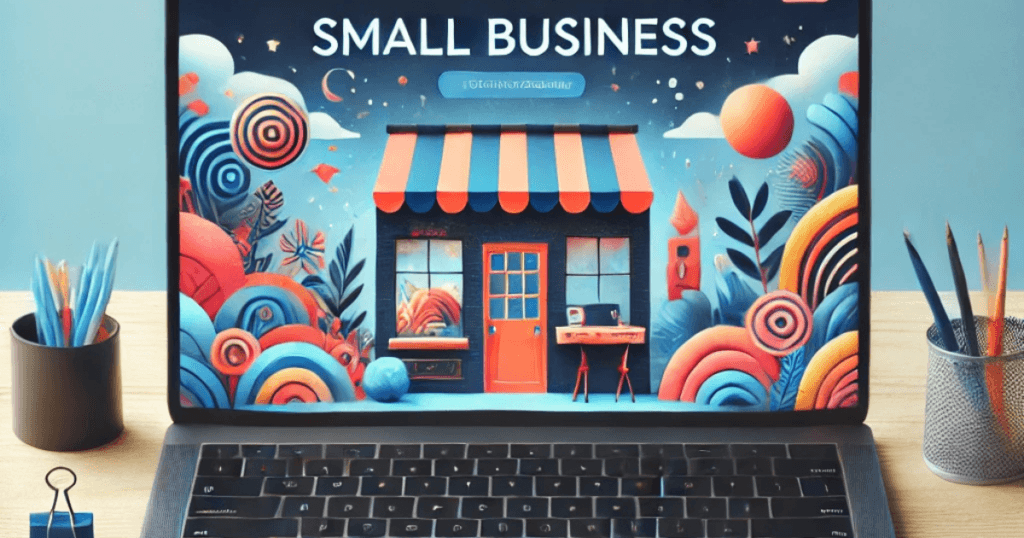Introduction
What is Custom Web Design?
Custom web design for small businesses involves creating a unique, tailored website that aligns with the specific needs, identity, and goals of a business. Unlike off-the-shelf templates, custom design is built from scratch to help businesses stand out in a competitive market and engage their audience effectively
The key differentiator in custom web design is its flexibility. A template-based site often restricts customization, leading to a generic, cookie-cutter appearance. In contrast, a custom-designed website ensures that every aspect, from the color palette to the layout, is crafted to reflect the brand’s personality and vision. For small businesses, this means the ability to tell a unique story that resonates with their customers.
A custom design is more than just aesthetic appeal. It’s also about creating a site that functions perfectly, providing an intuitive experience for users and ensuring that business goals are met. Whether it’s to increase leads, improve sales, or boost online presence, a custom web design can effectively address these needs.
Table of Contents
Importance of Web Design
Why Does Web Design Matter for Small Businesses?
In today’s digital age, having a website is no longer just a luxury—it’s a necessity. For small businesses, your website is often the first point of contact for potential customers. It’s essential that this first impression be impactful, professional, and memorable. Without a high-quality website, small businesses risk appearing outdated, unprofessional, or untrustworthy in the eyes of visitors.
The importance of web design goes beyond aesthetics. A website that is poorly designed can lead to frustrated users, lost opportunities, and a damaged reputation. However, a professionally designed website can serve as a powerful marketing tool. It is your virtual storefront, the face of your business in the digital world, and an essential piece of your branding strategy.
When small businesses invest in custom web design, they aren’t just improving the look and feel of their website—they are enhancing the user experience, increasing credibility, and setting themselves up for long-term success. In fact, studies show that visitors are more likely to engage with a business that has a well-designed, user-friendly website.
Moreover, web design plays a key role in a small business’s SEO strategy. Search engines like Google prioritize websites that offer excellent user experience, fast loading times, and responsive design. All these elements are critical to ranking higher in search engine results, leading to more organic traffic.

Benefits of Custom Design
Stand Out from Competitors
In the competitive online landscape, differentiating your business is crucial. Custom web design for small businesses provides a chance to create a unique website that truly represents your brand. With this approach, you’re not confined by the limitations of pre-made templates; you have the creative freedom to build something that speaks directly to your target audience.
Tailoring your website to your audience’s specific needs and behaviors is key. Custom web design for small businesses ensures that your site doesn’t just look good but also works as a conversion tool. Features like personalized content, dynamic navigation, and interactive elements give your website an edge over template-based designs.
For instance, a small eco-friendly business could benefit from a custom web design for small businesses, incorporating earthy tones and graphics that highlight its sustainable mission. This type of design creates a stronger emotional connection with visitors, far beyond the generic feel of a template
Flexibility and Scalability
One of the major benefits of custom web design is flexibility. As your business grows, your website needs to adapt. Custom web design ensures that your site can scale with you as new products, services, or features are introduced.
This flexibility is vital for small businesses that are constantly evolving. For example, you may begin with a basic informational website and later add e-commerce capabilities as your business expands. With custom design, the process of adding new features is seamless and doesn’t require a complete redesign.
Furthermore, a custom website is more adaptable to changing trends in design and technology. With template-based designs, updates can sometimes be difficult or impossible without reworking large portions of the site. Custom websites, on the other hand, are built with scalability in mind, ensuring your website remains modern and relevant for years to come.
Improved User Experience (UX)
User experience (UX) is a critical factor in the success of any website. A website with a poor UX will result in frustrated visitors who quickly bounce away, and this directly impacts your business’s performance. With a custom web design, the user experience is prioritized from the start, ensuring that your website is not only beautiful but also functional.
Custom websites are designed with usability in mind—navigation is intuitive, content is well-organized, and visitors can quickly find what they’re looking for. This reduces the likelihood of visitors abandoning the site due to frustration. Moreover, custom websites allow for the optimization of key design elements such as call-to-action buttons, landing pages, and forms—all strategically placed to increase conversions.
In addition to usability, custom design also allows for speed optimization, making sure your website loads quickly on all devices. Site speed is a crucial factor not only for user satisfaction but also for search engine ranking.
Key Features
Mobile Responsiveness
With over half of global internet traffic coming from mobile devices, it’s essential that your website be mobile-friendly. A responsive design ensures that your website adapts to any screen size, from smartphones to tablets and desktops. This flexibility is crucial in ensuring that visitors have an optimal browsing experience, regardless of the device they’re using.
Mobile responsiveness is a key feature of custom web design. Unlike template-based websites that may have mobile versions that are clunky or difficult to navigate, a custom web design is fully optimized for mobile devices from the ground up. This attention to detail not only improves the user experience but also helps in improving your site’s SEO, as search engines give preference to mobile-friendly websites.
SEO-Friendly Design
Search engine optimization (SEO) is essential for driving organic traffic to your website. A custom-designed website is built with SEO in mind, ensuring that it is easily indexed by search engines like Google. SEO involves optimizing various elements of your website—such as keywords, meta tags, image alt text, and page load times—to improve your rankings in search results.
With custom web design, your site can be structured in a way that makes it easier for search engines to crawl and index. For example, custom design ensures that the URL structure is clean, the site is fast, and the content is optimized for keywords relevant to your business. Additionally, custom web designers often integrate the latest SEO best practices into the development process, which helps your website rank higher in search results.
A custom site also allows for better control over elements like content hierarchy, which impacts how Google ranks your pages. Whether you’re targeting local customers or a global audience, custom design offers a clear advantage in terms of SEO optimization.
Brand Consistency
Branding is crucial for establishing trust and recognition with your customers. A custom web design ensures that your website fully reflects your brand’s colors, fonts, logo, tone, and messaging. Consistent branding across your website and other marketing materials helps build familiarity and credibility with your audience.
Custom web design enables you to create a cohesive look that aligns with your other branding efforts, such as social media, advertisements, and offline materials. For example, if your brand’s personality is playful and vibrant, your website can incorporate bright colors, fun typography, and interactive elements that embody that tone.
By aligning the visual elements of your website with your brand’s identity, you create a more professional and trustworthy online presence. Consistent branding also improves the overall user experience, as visitors can quickly recognize your brand and feel more comfortable interacting with your site.

Process Overview
Understanding Business Goals
The process of custom web design starts with a deep understanding of your business’s goals. This is the foundation upon which the entire project is built. During this stage, you’ll work closely with your web designer to define key objectives: What are you hoping to achieve with your website? Do you want to generate leads, increase sales, build brand awareness, or something else entirely?
Understanding these goals is crucial because it helps shape the design and functionality of your website. For example, if your goal is to increase conversions, the designer will focus on creating clear calls to action, strategically placing lead forms, and ensuring the user journey is as smooth as possible.
The business goal phase is also when designers will learn about your target audience—who they are, what they’re looking for, and how they interact with websites. This information is critical for ensuring that your custom web design resonates with your ideal customers.
Wireframing and Prototyping
Before diving into the actual design, it’s important to map out the website’s structure through wireframing. A wireframe is a basic visual guide that represents the skeletal framework of your website. It outlines the placement of key elements such as the navigation menu, content sections, and footer.
Once the wireframe is approved, a prototype is developed. This is an interactive model of the website that allows you to click through and experience how the site will function. Prototyping is an important step because it provides an opportunity to test the user experience and make adjustments before moving on to the final design and development phase.
Designing and Development
After the wireframe and prototype have been approved, the designer begins to work on the visual elements of the website. This involves choosing colors, typography, images, and other design elements that align with your brand. The goal is to create a visually stunning website that engages visitors and encourages them to take action.
Once the design is finalized, the development phase begins. During this stage, the website is built using coding languages like HTML, CSS, and JavaScript. The developers will ensure that all interactive elements function properly, the website is optimized for speed, and that it works seamlessly across all devices.
Cost Considerations
Factors Influencing Cost
The cost of a custom web design project depends on various factors, including the complexity of the site, the number of pages, the features required, and the experience of the designer. Generally, more complex websites with advanced functionalities such as e-commerce, custom databases, or integrations with third-party systems will cost more to develop.
The design process also influences the cost. Websites that require extensive custom graphics, animations, or unique design elements will require more time and expertise, resulting in higher costs. The development phase also plays a role in cost, especially if custom coding or features are needed.
Budget-Friendly Tips
For small businesses with a limited budget, there are ways to reduce costs while still getting a high-quality custom website. One option is to start with a simpler design and gradually add more features as your business grows. Another cost-saving strategy is to work with a freelance web designer or a smaller agency, as they often have lower overhead costs than large firms.
Additionally, using a content management system (CMS) like WordPress allows for easier content updates and management, reducing long-term maintenance costs. By carefully planning your website’s design and features, you can ensure that your custom web design fits within your budget without sacrificing quality.
Finding the Right Partner
How to Choose a Web Designer
Choosing the right web designer is a critical step in the custom web design process. The designer or agency you select should have experience working with small businesses and a portfolio that aligns with your vision. When reviewing portfolios, look for websites that reflect creativity, functionality, and a user-friendly experience.
In addition to examining their work, consider their communication skills. Your web designer should be someone who listens to your needs and is willing to collaborate with you throughout the process. A good designer will take the time to understand your business, target audience, and goals to ensure that the final product is aligned with your vision.
Questions to Ask Your Designer
To ensure that you’re selecting the right partner for your custom web design project, ask the following questions:
- What is your design process, and how long does it typically take?
- Can you provide case studies or references from past clients?
- Do you offer post-launch support for maintenance and updates?
- How do you approach SEO in your designs?
- What is your pricing structure, and what is included in the cost?
These questions will give you a better understanding of the designer’s expertise and how they will approach your project.

Success Stories
Real-World Examples of Custom Web Design Impact
Custom web design can be a game-changer for small businesses. Take the example of a local boutique that invested in a custom-designed website with an integrated online store. Within a few months, the boutique saw a 60% increase in online sales due to improved user experience, better navigation, and an enhanced brand presence.
Another example is a small law firm that redesigned its website with a custom design. The site now showcases client testimonials, detailed service pages, and an easy-to-navigate consultation booking system. As a result, the law firm has seen a noticeable uptick in client inquiries and new business.
These success stories highlight the power of custom web design in driving business growth and improving customer engagement.
Conclusion
Custom Web Design: A Game-Changer for Small Businesses
In conclusion, custom web design is an invaluable investment for small businesses. It provides a unique opportunity to create a website that truly represents your brand, stands out from competitors, and offers an exceptional user experience. When done correctly, custom web design can improve your online visibility, increase conversions, and help your business grow.
By carefully considering your business goals, understanding the design process, and partnering with the right designer, you can create a website that not only meets your needs but exceeds your expectations. Don’t settle for a generic template—invest in custom web design and give your business the online presence it deserves.
FAQs
1. How much does custom web design cost?
The cost of custom web design can range anywhere from $2,000 to $10,000, depending on factors like complexity, features, and the experience of the designer.
2. How long does it take to build a custom website?
On average, it takes between 4 to 12 weeks to complete a custom web design project. The timeline depends on the scope of the project.
3. Can I update my custom website myself?
Yes, most custom websites are built on user-friendly platforms such as WordPress or other content management systems (CMS) that allow you to make updates easily.
4. Is custom web design better for SEO?
Yes, custom web design provides the flexibility to build SEO-friendly sites from the ground up, ensuring faster load times, optimized content, and clean code—all of which improve your search engine rankings.
5. Can I redesign my existing website?
Yes, redesigning your website with a custom design is a great way to refresh your online presence, improve functionality, and align with current business goals.
